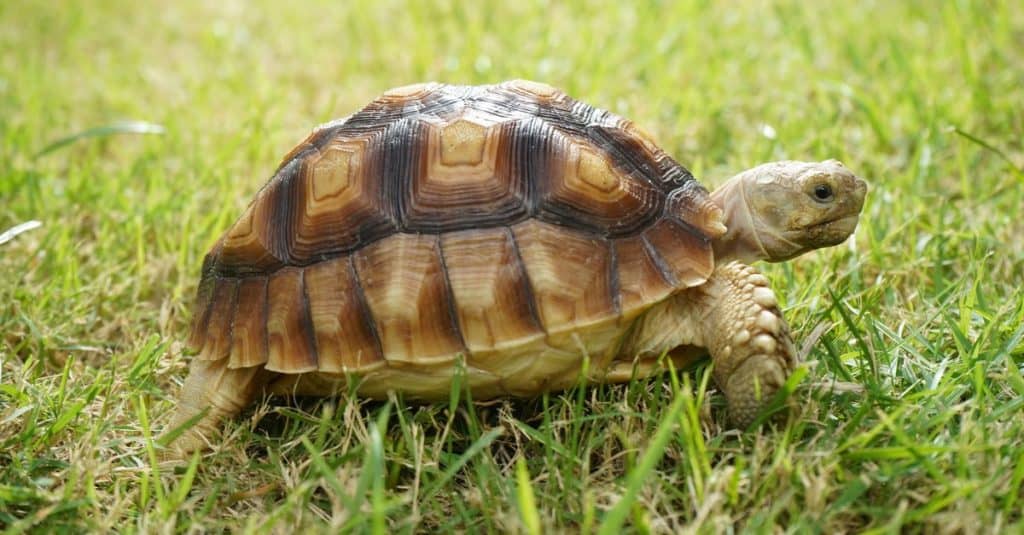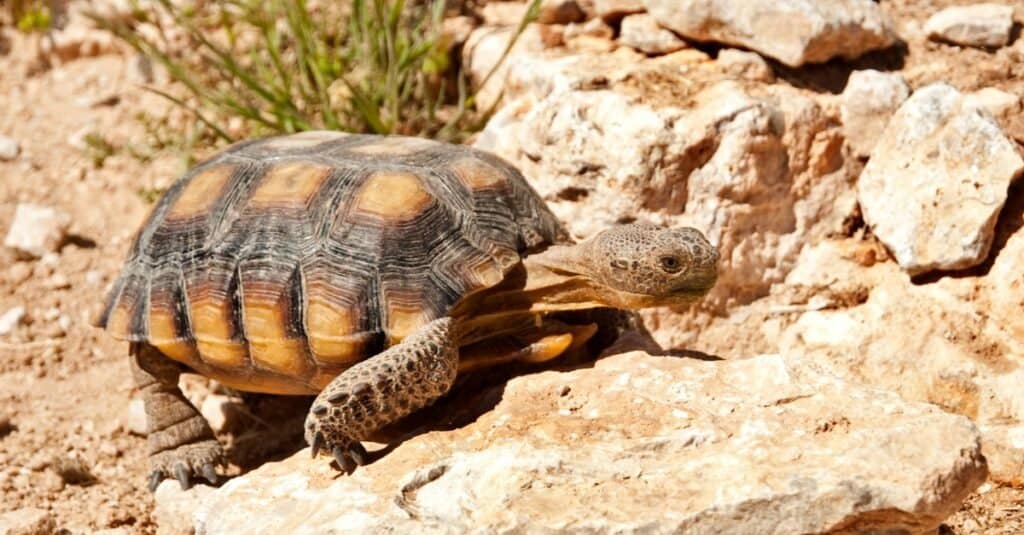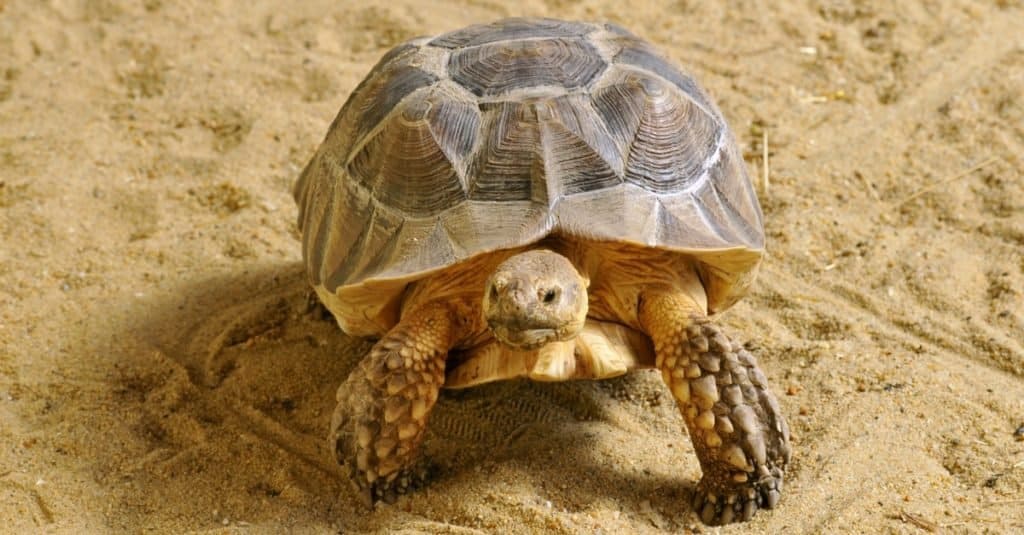Tortoises are among the longest-living animals in the world. Some of these land turtles can live up to 150 years! Alipore Zoological Garden reported an Aldabra giant tortoise named Adwaita that lived for 255 years!
Tortoises vary between continents. According to studies, there are approximately 357 species of turtles and tortoises, and more than half are threatened. Some tortoises may look similar at first glance, but several distinctive features differentiate them.
Desert tortoises and sulcata tortoises belong to the Testudinidae family of tortoises. They live in dry habitats, but their sizes, color variations, and skins differ. Read on if you want to learn how to tell the difference between the two.
Comparing Desert Tortoise vs. Sulcata Tortoise
| Desert Tortoise | Sulcata Tortoise | |
|---|---|---|
| Size | Weight: 8 lbs to 15 lbs (4 kg to 7 kg) Length: 10 to 14 inches (25 cm to 36 cm) | Weight: 79 to 200 lbs (36 to 91 kg) Length: up to 30 inches (76 cm) |
| Color variations | Brown, yellow, black, tan | Brown, yellow |
| Skin Type | Scales | Large scales |
| Diet | Herbivore | Herbivore |
| Habitat | Sandy desert plains and rocky hills | Desert, dry savanna |
| Origin | Central-AmericaNorth-America | Africa |
| Hatchling size | About 1.5 inches long | 1.57 to 2.36 inches long |
| Lifespan | 25 – 60 years | More than 70 years |
The Key Differences Between Desert Tortoise vs. Sulcata Tortoise
Desert tortoises and sulcata tortoises can both survive in dry and hot climates. However, their habitats and lifespans differ. That’s why certain distinctive features, such as their size, color variations, and even their shells, are noticeable. Here are the key differences between desert tortoises and sulcata tortoises.
Desert Tortoise vs. Sulcata Tortoise: Distribution

Sulcata tortoises are distributed throughout the African continent.
©Sutthiphong Chandaeng/Shutterstock.com
Desert tortoises are distributed throughout North America and Central America. African spurred, or sulcata tortoises, are distributed throughout the African continent. They are most prevalent in the southern part of the Sahara. Tortoises play a major role in African culture. Some tribes even believe they connect humans with gods by being their intermediary.
Desert Tortoise vs. Sulcata Tortoise: Size
Desert tortoises and sulcata tortoises differ in terms of average size. Desert tortoises, also called Gopherus agassizii, can grow 10 to 14 inches (25 cm to 36 cm) long and weigh 8 lbs to 15 lbs (4 kg to 7 kg). Sulcata tortoises, also called Centrochelys sulcata, can grow up to 30 inches (76 cm) long and weigh 79 to 200 lbs (36 to 91 kg).
Desert Tortoise vs. Sulcata Tortoise: Color variations
Unlike other turtles with colorful shells, the colors of desert tortoises vary between brown, yellow, black, and tan. Sulcata tortoises only have brown and yellow color variations. They can have lighter or darker shades.
Desert Tortoise vs. Sulcata Tortoise: Shells

Desert tortoises do not have colorful markings.
©Darren J. Bradley/Shutterstock.com
Desert tortoises do not have colorful markings, but their shells have embossed scutes that are slightly flattened and light colored on the top. The darker line patterns make the divisions on their shells more visible. The shells of sulcata tortoises are almost oval and have well-defined grooves. Sulcata tortoises with a normal healthy shell will have visible embossed divisions called scutes with attractive annular rings, and pyramiding might happen when they grow.
Habitat loss and their late sexual maturity are only some of the reasons for the declining tortoise population. These animals are also hunted for their shells. Over the years, people have learned to appreciate tortoise shells. They use them as ornamental gems for jewelry, combs, or even eyeglass frames. Tortoise shells are part of their skeleton and the extension of their ribcage, so they can not be replaced or switched.
Desert Tortoise vs. Sulcata Tortoise: Skin
Tortoises are reptiles, and their skins and shells undergo shedding for growth. Studies show that tortoises can withstand months without water because their thick skins reduce water loss. However, they will overheat inside their shells if they stay in the hot summer sun for too long. Desert tortoises have thick, small scales on the skin of their limbs. Sulcata tortoises have large, pointed scales on the skin of their front legs.
Desert Tortoise vs. Sulcata Tortoise: Habitat

Sulcata tortoises live in savannas, which are tropical grasslands with widely scattered trees.
©Christian Musat/Shutterstock.com
Another way tortoises survive long periods without moisture is by digging and living in burrows to help regulate their body temperature. Desert tortoises burrow in desert plains and rocky hills. Vegetation and plant growth are limited because these habitats are dry and consist primarily of sand. Fortunately, they can survive long periods without water. Desert tortoises may burrow in the same spot for several weeks before transferring to another location. On the other hand, they may also use several burrows within their ‘home’ range. Desert tortoises’ burrows have a distinctive crescent shape and a slightly angled downward slant.
Sulcata tortoises live in savannas, which are tropical grasslands with widely scattered trees. According to biologists, savannas are transitional biomes – a combination of forests and deserts. Sulcata tortoises can dig up to 49 feet deep.
Desert Tortoise vs. Sulcata Tortoise: Brumation (Hibernation)
Like some mammals, some reptiles undergo a dormancy period. The technical term for it is brumation. Desert tortoises brumate on a burrow during winter. Sulcatas do not brumate. To learn more about the difference between brumation and hibernation, check out ‘Brumation vs. Hibernation: What Are the Differences?’
Desert Tortoise vs. Sulcata Tortoise: Hatchling size
Tortoise hatchling sex doesn’t depend on chromosomes, but on the temperature the egg was exposed to. Desert tortoise hatchlings measure about 1.5 inches (3.81 cm) long and weigh less than a pound. Sulcata tortoise hatchlings measure 1.57 to 2.36 inches (3.9 to 5.9 cm) long and weigh less than half an ounce.
Desert Tortoise vs. Sulcata Tortoise: Lifespan

Desert tortoises live for about 25 to 60 years.
©iStock.com/GoDogPhoto
Some studies show that tortoises can live more than 150 years. The average desert tortoise’s lifespan is about 25 to 60 years. Sulcata tortoises have an average lifespan of more than 70 years.
Up Next:
- 10 Incredible Desert Tortoise Facts
- 100-Pound Tortoise Traps Two Curious Puppies in Its Den and Refuses to Move
- 10 Incredible Galápagos Tortoise Facts
The photo featured at the top of this post is ©
Sources
- Ask A Biologist, Available here: https://askabiologist.asu.edu/explore/savanna#:~:text=Savannas%20are%20a%20transitional%20biome,the%20world%20%E2%80%93%20the%20African%20elephant.
- Google Books, Available here: https://books.google.com.ph/books?hl=en&lr=&id=c9rhHw3PWo8C&oi=fnd&pg=PA1&dq=largest+Desert+Tortoise&ots=wX0do8DtAX&sig=QcCeKqicP6vaGIFO4QeEuScCMxU&redir_esc=y#v=onepage&q=largest%20Desert%20Tortoise&f=false
- IUCN/SSC, Available here: http://doi.org/10.3854/crm.5.000.checklist.v7.2014
Thank you for reading! Have some feedback for us? Contact the AZ Animals editorial team.







